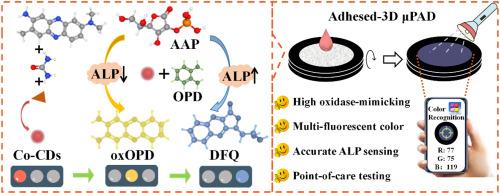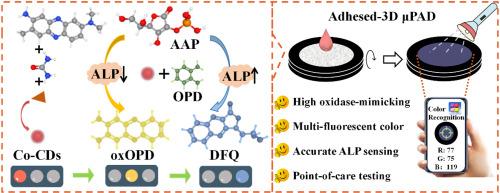Adhered-3D paper microfluidic analytical device based on oxidase-mimicking activity of Co-doped carbon dots nanozyme for point-of-care testing of alkaline phosphatase
IF 6
2区 化学
Q1 CHEMISTRY, ANALYTICAL
引用次数: 0
Abstract
Paper-based microfluidic analytical devices (μPADs) have become promising alternatives to clinical laboratory-based methods for point-of-care testing (POCT) of biomarkers in family care and resource-limited communities. Here, Co-doped carbon dots (Co-CDs) nanozyme with outstanding oxidase-mimicking catalytic activity and red fluorescent emission were prepared, and combined adhered-3D μPAD (A-3D μPAD) to monitor facilely alkaline phosphatase (ALP) level in whole blood samples. Co-CDs catalyzed the oxidization of nonfluorescent o-phenylenediamine (OPD) into 2,3-diaminophenazine (oxOPD) with yellow fluorescent emission due to the generation of tremendous O2•- species. With addition of ALP, ALP hydrolyzed l-ascorbic acid 2-phosphate into ascorbic acid, and the latter was oxidized by Co-CDs, then reacted with OPD to form blue fluorescent emission 3-(dihydroxyethyl)furo [3,4-b]quinoxaline-1-one (DFQ). Both DFQ and oxOPD quenched the fluorescence intensity of Co-CDs via inner-filter effect. The cascade reaction of ALP/Co-CDs was incorporated into A-3D μPAD based on above sensing principles. A-3D μPAD enabled sample pretreatment, cascade reaction and signal output, and integrated portable minimized device and smartphone for visual ALP detection. The linear range and limit of detection for ALP were 0.5–150 U L−1 and 0.1 U L−1, respectively, and the color varied from red, yellow to blue. The detection results for whole blood samples were consistent with biochemical detector. The efficiency, disposability, practicality and low-cost of A-3D μPAD can be extended to determine various biomarkers, and provided technical support for nanozyme applications in POCT environments.


基于共掺杂碳点纳米酶的氧化酶模拟活性的粘附-3D 纸微流体分析装置,用于碱性磷酸酶的床旁检测
基于纸张的微流控分析装置(μPADs)已成为临床实验室方法的理想替代品,可用于家庭护理和资源有限社区的床旁生物标记物检测(POCT)。本文制备了具有出色的氧化酶模拟催化活性和红色荧光发射的掺钴碳点(Co-CDs)纳米酶,并将其与附着型三维μPAD(A-3D μPAD)相结合,以方便地监测全血样本中的碱性磷酸酶(ALP)水平。Co-CDs 催化无荧光的邻苯二胺(OPD)氧化成 2,3-二氨基吩嗪(oxOPD),由于生成了大量的 O2 物种,所以会发出黄色荧光。加入 ALP 后,ALP 将 L-抗坏血酸 2-磷酸水解为抗坏血酸,后者被 Co-CDs 氧化,然后与 OPD 反应生成发出蓝色荧光的 3-(二羟乙基)呋喃并[3,4-b]喹喔啉-1-酮(DFQ)。DFQ 和 oxOPD 都能通过内滤效应淬灭 Co-CD 的荧光强度。根据上述传感原理,ALP/Co-CDs 的级联反应被整合到了 A-3D μPAD 中。A-3D μPAD 实现了样品预处理、级联反应和信号输出,并集成了便携式微型装置和智能手机,可实现可视化 ALP 检测。ALP 的线性范围和检测限分别为 0.5-150 U L-1 和 0.1 U L-1,颜色从红色、黄色到蓝色不等。全血样本的检测结果与生化检测器一致。A-3D μPAD 的高效性、可抛弃性、实用性和低成本可扩展到多种生物标记物的检测,为纳米酶在 POCT 环境中的应用提供了技术支持。
本文章由计算机程序翻译,如有差异,请以英文原文为准。
求助全文
约1分钟内获得全文
求助全文
来源期刊

Analytica Chimica Acta
化学-分析化学
CiteScore
10.40
自引率
6.50%
发文量
1081
审稿时长
38 days
期刊介绍:
Analytica Chimica Acta has an open access mirror journal Analytica Chimica Acta: X, sharing the same aims and scope, editorial team, submission system and rigorous peer review.
Analytica Chimica Acta provides a forum for the rapid publication of original research, and critical, comprehensive reviews dealing with all aspects of fundamental and applied modern analytical chemistry. The journal welcomes the submission of research papers which report studies concerning the development of new and significant analytical methodologies. In determining the suitability of submitted articles for publication, particular scrutiny will be placed on the degree of novelty and impact of the research and the extent to which it adds to the existing body of knowledge in analytical chemistry.
 求助内容:
求助内容: 应助结果提醒方式:
应助结果提醒方式:


